1995 GMC SIERRA wiper blades
[x] Cancel search: wiper bladesPage 103 of 488
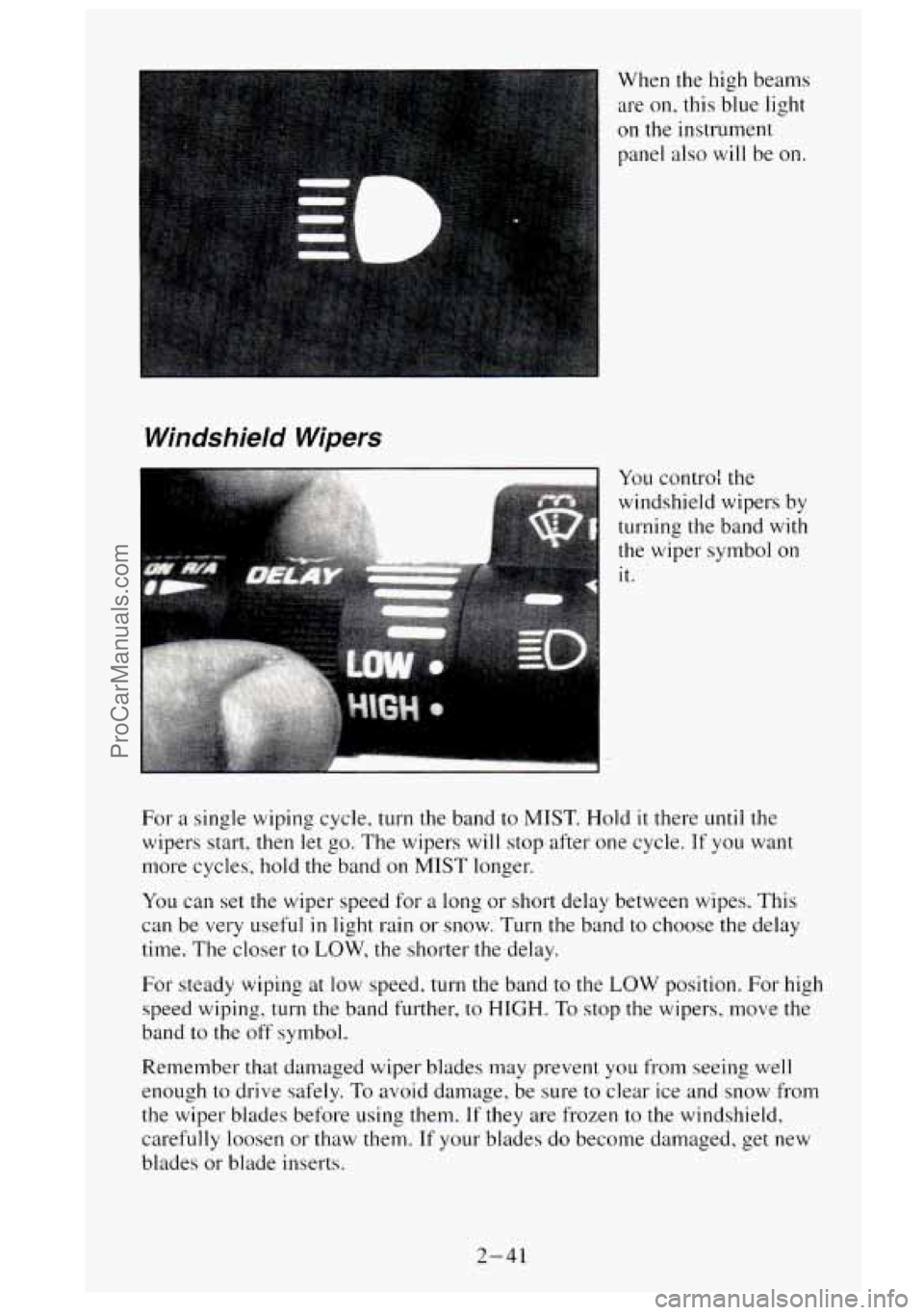
When the high beams
are
on. this blue light
on the instrument
panel also
will be on.
Windshield Wipers
You contro: the
windshield wipers by
turning the band with
the wiper symbol
on
it.
..... ".. .... ~..
For a single wiping cycle, turn the band to MIST. Hold it there until the
wipers start, then let
go. The wipers will stop after one cycle. If you want
more cycles, hold the band
on MIST longer.
You can set the wiper speed for a long or short delay between wipes. This
can be very useful in light rain
or snow. Turn the band to choose the delay
time. The closer to LOW, the shorter the delay.
For steady wiping at low speed, turn the band to the LOW position. For high
speed wiping,
turn the band further, to HIGH. To stop the wipers, move the
band to the
off symbol.
Remember that damaged wiper blades may prevent you from seeing well
enough
to drive safely. To avoid damage, be sure to clear ice and snow from
the wiper blades before using them.
If they are frozen to the windshield,
carefully loosen or thaw them.
If your blades do become damaged, get new
blades or blade inserts.
2-41
ProCarManuals.com
Page 199 of 488
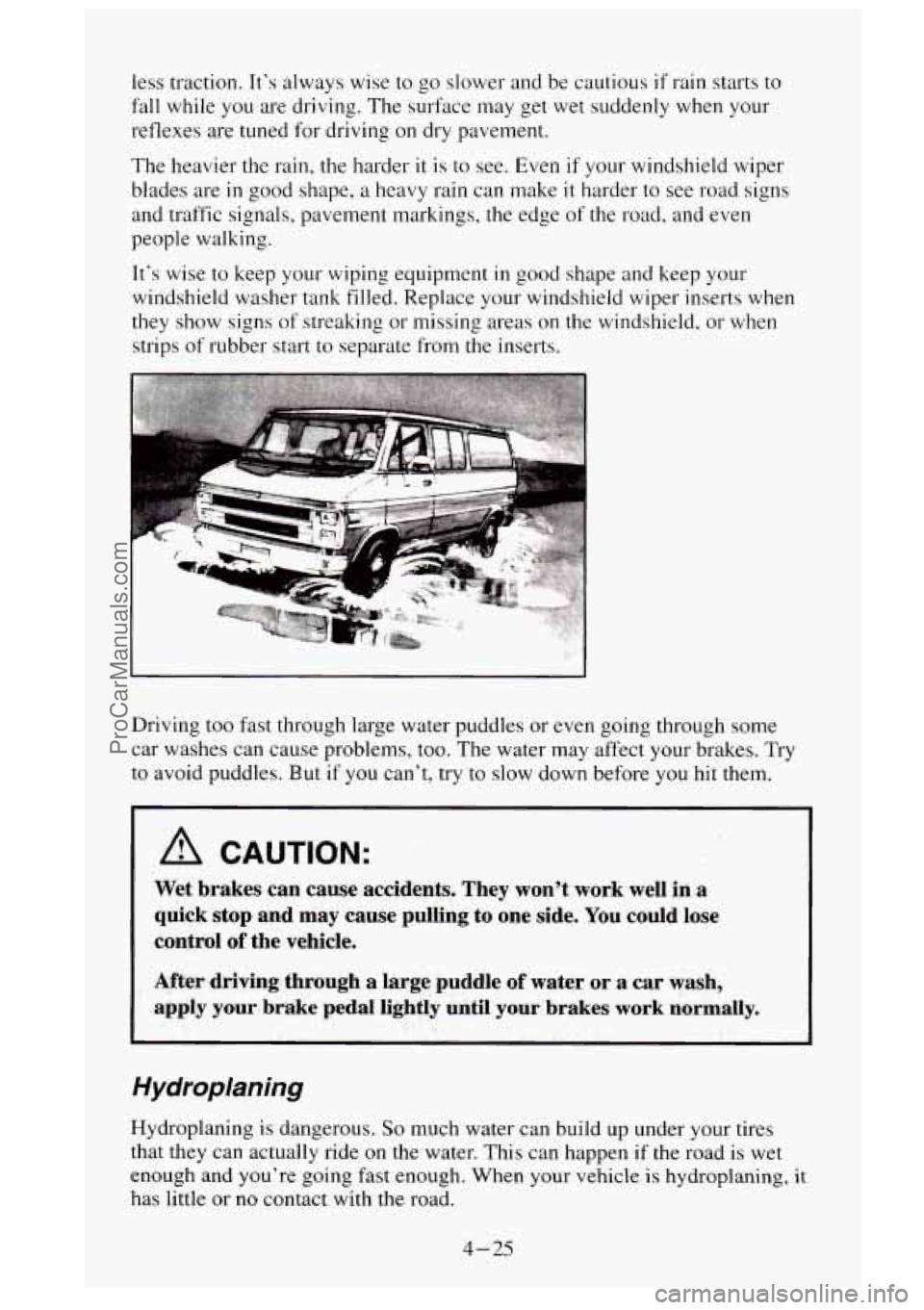
less traction. It‘s always wise to go slower and be cautious if rain starts to
fall while you are driving. The surface may get wet suddenly when your
reflexes are tuned for driving on dry pavement.
The heavier the rain, the harder
it is to see. Even if your windshield wiper
blades are
in good shape, a heavy rain can make it harder to see road signs
and traffic signals, pavement markings, the edge of the road, and even
people walking.
It‘s wise to keep
your wiping equipment in good shape and keep your
windshield washer tank filled. Replace your windshield wiper inserts when
they show signs
of streaking or missing areas on the windshield, or when
strips
of rubber start to separate from the inserts.
Driving too fast through large water puddles or even going through
some
car washes can cause problems, too. The water may affect your brakes. Try
to avoid puddles. But
if you can’t, try to slow down before you hit them.
A CAUTION:
Wet brakes can cause accidents. They won’t work well in a
quick stop and may cause pulling to one side. You could lose
control
of the vehicle.
After driving through a large puddle of water or a car wash,
apply your brake pedal lightly until your brakes work normally.
Hydroplaning
Hydroplaning is dangerous. So much water can build up under your tires
that they can actually ride on the water. This can happen
if the road is wet
enough and you’re going fast enough. When your vehicle is hydroplaning,
it
has little or no contact with the road.
4-25
ProCarManuals.com
Page 202 of 488
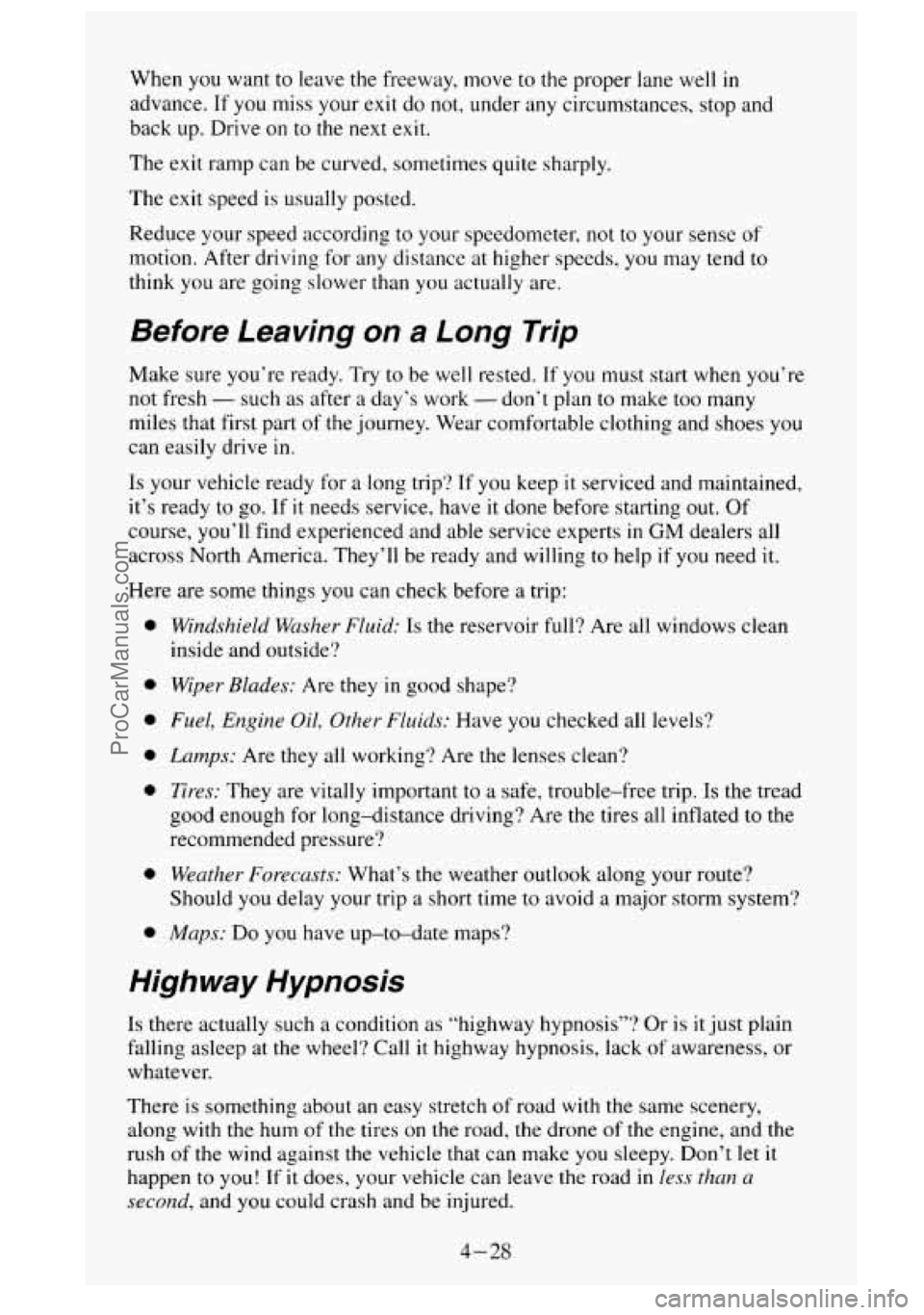
When you want to leave the freeway, move to the proper lane well in
advance. If
you miss your exit do not, under any circumstances, stop and
back up. Drive on
to the next exit.
The exit ramp can be curved, sometimes quite sharply.
The
exit speed is usually posted.
Reduce your speed according to your speedometer, not to your sense
of
motion. After driving for any distance at higher speeds, you may tend to
think you are going slower than you actually are.
Before Leaving on a Long Trip
Make sure you’re ready. Try to be well rested. If you must start when you’re
not fresh
- such as after a day’s work - don’t plan to make too many
miles that first part
of the journey. Wear comfortable clothing and shoes you
can easily drive
in.
Is your vehicle ready for a long trip‘? If you keep it serviced and maintained,
it’s ready to go.
If it needs service, have it done before starting out. Of
course, you’ll find experienced and able service experts
in GM dealers all
across North America. They’ll be ready and willing to help if you need it.
Here are some things you can check before a trip:
0
0
0
0
0
a
0
Windshield Washer Fluid: Is the reservoir full? Are all windows clean
inside and outside?
Wiper Blades: Are they in good shape?
FueZ, Engine Oil, Other Fluids: Have you checked all levels?
Lamps: Are they all working? Are the lenses clean?
Tires: They are vitally important to a safe, trouble-free trip. Is the tread
good enough for long-distance driving? Are
the tires all inflated to the
recommended pressure?
Weather Forecasts: What’s the weather outlook along your route?
Should
you delay your trip a short time to avoid a major storm system?
Maps: Do you have up-to-date maps?
Highway Hypnosis
Is there actually such a condition as “highway hypnosis”? Or is it just plain
falling asleep at the wheel? Call it highway hypnosis, lack of awareness, or
whatever.
There
is something about an easy stretch of road with the same scenery,
along with the
hum of the tires on the road, the drone of the engine, and the
rush
of the wind against the vehicle that can make you sleepy. Don’t let it
happen
to you! If it does, your vehicle can leave the road in less than a
second, and you could crash and be injured.
4-28
ProCarManuals.com
Page 337 of 488
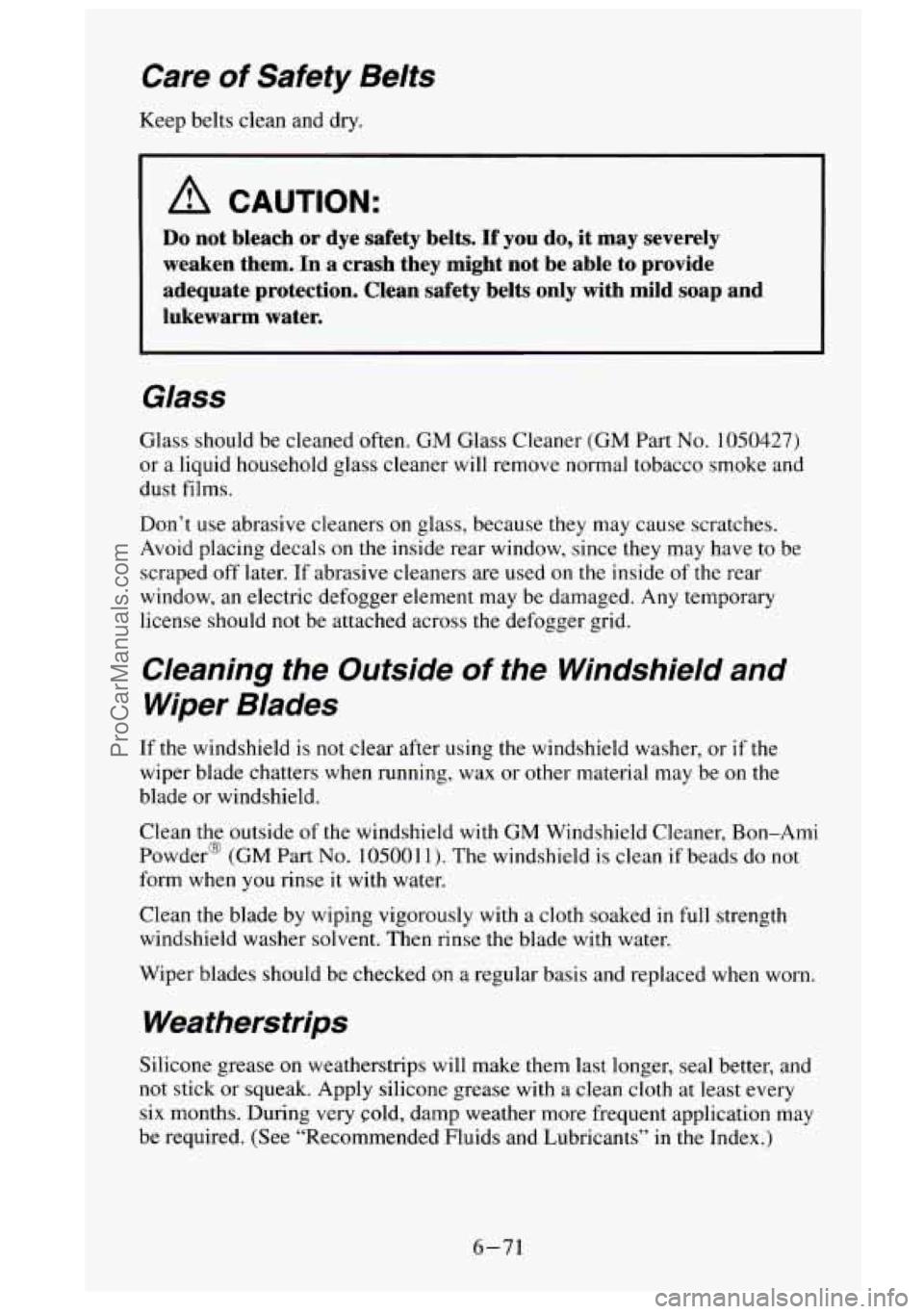
Care of Safety Belts
Keep belts clean and dry.
A CAUTION:
Do not bleach or dye safety belts. If you do, it may severely
weaken them. In a crash they might not be able to provide
adequate protection. Clean safety belts only with mild soap and\
lukewarm water.
Glass
Glass should be cleaned often. GM Glass Cleaner (GM Part No. 1050427)
or a liquid household glass cleaner will remove normal tobacco smoke and
dust films.
Don’t use abrasive cleaners
on glass, because they may cause scratches.
Avoid placing decals on the inside rear window, since they may have to be
scraped off later. If abrasive cleaners are used on the inside
of the rear
window, an electric defogger element may be damaged. Any temporary
license should not be attached across the defogger grid.
Cleaning the Outside of the Windshield and
Wiper Blades
If the windshield is not clear after using the windshield washer, or if the
wiper blade chatters when running, wax or other material may be on the
blade or windshield.
Clean the outside of the windshield with GM Windshield Cleaner, Bon-Ami
Powder@ (GM
Part No. 105001 1). The windshield is clean if beads do not
form when
you rinse it with water.
Clean
the blade by wiping vigorously with a cloth soaked in full strength
windshield washer solvent. Then rinse the blade with water.
Wiper blades should be checked
on a regular basis and replaced when worn.
Weatherstrips
Silicone grease on weatherstrips will make them last longer, seal better, and
not stick or squeak. Apply silicone grease with a clean cloth at least every
six months. During very cold, damp weather more frequent application may
be required. (See “Recommended Fluids and Lubricants” in the Index.)
6-71
ProCarManuals.com
Page 474 of 488
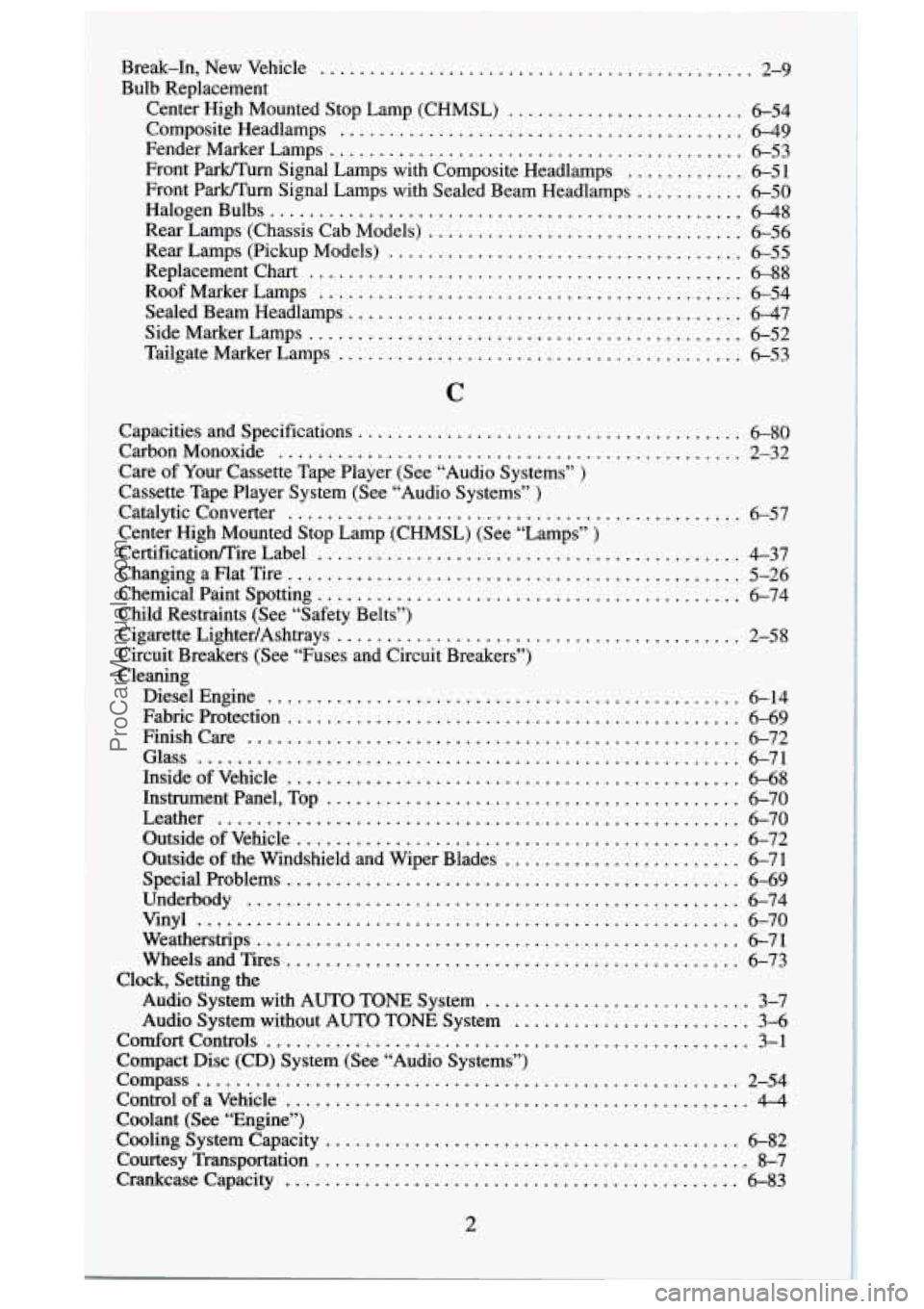
Break.In. New Vehicle ............................................ 2-9
Composite Headlamps ......................................... 6-49
Bulb Replacement Center
High Mounted Stop Lamp (CHMSL) ........................ 6-54
Fender Marker Lamps .......................................... 6-53
Front Park/Turn Signal Lamps with Composite Headlamps ............ 6-51
Front Park/Turn Signal Lamps with Sealed Beam Headlamps ........... 6-50
HalogenBulbs ................................................ 6-48
Rear Lamps (Chassis Cab Models) ................................ 6-56
Rear Lamps (Pickup Models) .................................... 6-55
Replacement Chart ............................................. 6-88
Roof Marker Lamps ........................................... 6-54
Sealed Beam Headlamps ........................................ 6-47
Side Marker Lamps ............................................ 6-52
Tailgate Marker Lamps ......................................... 6-53
C
Capacities and Specifications ....................................... 6-80
CarbonMonoxide ............................................... 2-32
Care of Your Cassette Tape Player (See “Audio Systems” )
Cassette Tape Player System (See “Audio Systems” )
Catalyticconverter .............................................. 6-57
Center High Mounted Stop Lamp (CHMSL) (See “Lamps” )
Certificatioflire Label ........................................... 4-37
Changing a Flat Tire .............................................. 5-26
Chemical Paint Spotting ........................................... 6-74
Cigarette LightedAshtrays ......................................... 2-58
Child Restraints (See “Safety Belts”)
Circuit Breakers (See “Fuses and Circuit Breakers”)
Cleaning DieselEngine
................................................ 6-14
Fabric Protection .............................................. 6-69
Finishcare .................................................. 6-72
Glass ....................................................... 6-71
InsideofVehicle .............................................. 6-68
Leather ..................................................... 6-70
Instrument Panel, Top .......................................... 6-70
Outside of Vehicle ............................................. 6-72
Outside of the Windshield and Wiper Blades ........................ 6-71
Special Problems .............................................. 6-69
Vinyl ....................................................... 6-70
Weatherstrips ................................................. 6-71
Audio System with AUTO TONE System ........................... 3-7
Audio System without AUTO TONE System ........................ 3-6
Underbody .................................................. 6-74
WheelsandTires .............................................. 6-73
Clock, Setting the
ComfortControls
................................................. 3-1
Compact Disc (CD) System (See “Audio Systems”)
Compass
....................................................... 2-54
Control of a Vehicle ............................................... 4-4
Coolant (See “Engine”)
Cooling System Capacity
.......................................... 6-82
Courtesy Transportation ............................................ 8-7
CrankcaseCapacity .............................................. 6-83
2
ProCarManuals.com